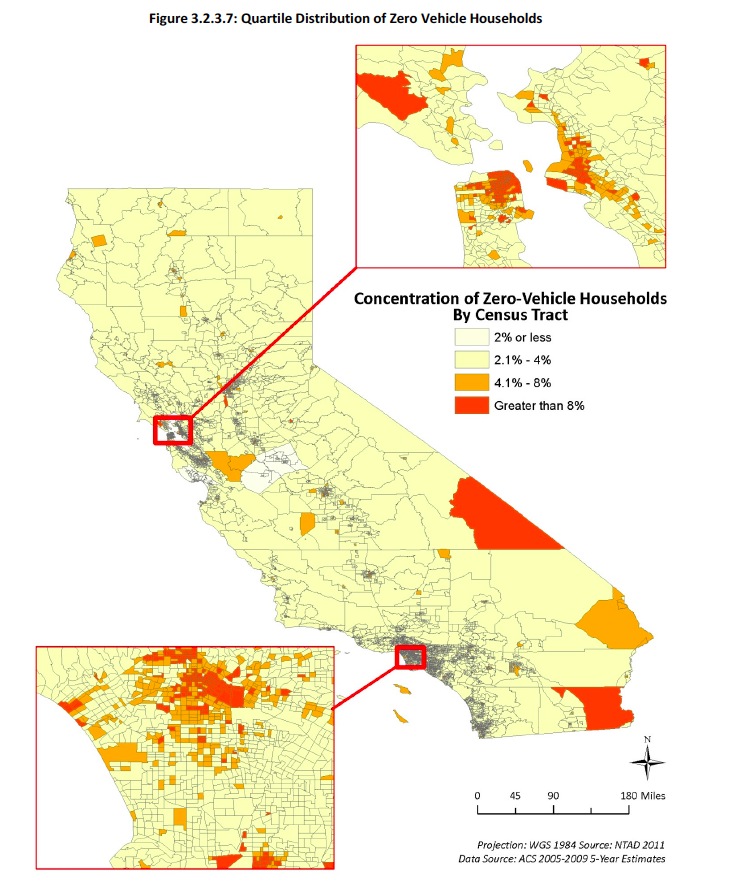CALIFORNIA DEPARTMENT OF TRANSPORTATION
1.0 Executive Summary
The 2010-2012 California Household Travel Survey (CHTS) was a unique statewide, collaborative effort to gather travel information needed for regional and statewide travel and environmental models using the same instrument and methods across the state. Led by the California Department of Transportation (Caltrans), the survey was jointly funded by the California Strategic Growth Council, the California Energy Commission (Energy Commission), and eight transportation planning agencies across the state. Guidance and direction for the survey effort was provided by an Administrative Committee, composed of representatives from the funding agencies, and a Steering Committee composed of all stakeholders, including the California Air Resources Board, the California Department of Public Health, the California Department of Housing and Community Development, and all transportation planning agencies.
1.1 Survey Overview
The CHTS was designed to collect travel information from households in all of California’s 58 counties, plus portions of three adjacent counties in Nevada, using combination of computer assisted telephone interviewing (CATI), online, and three types of global positioning systems (GPS) devices–wearable, in-vehicle and in-vehicle plus an on-board diagnostic (OBD) unit. The survey design was pretested in late fall, 2011, and the main survey effort began in January, 2012. Travel information was collected for every day for a full year. All participating households were first recruited to record their travel in a diary for a pre-assigned 24-hour period, plus report long distance travel in the prior eight weeks. Households that participated in the GPS assisted survey used the wearable GPS devices for a total of three days, and the in-vehicle or in-vehicle plus OBD devices for a total of seven days. The travel data was retrieved either by CATI, online, or by returning the travel diaries, long distance log and GPS devices (if applicable) by mail.
There were 42,431 completed households, which includes 36,714 non-GPS households and 5,717 GPS households. Of the GPS households 3,855 were wearable GPS, 422 used in-vehicle GPS only, and 1,440 used in-vehicle GPS plus OBD. In addition, NuStats delivered 20,651 households that were partially complete, as several funding partners considered these data as being useful.
The overall recruit response rate for the main survey was 4.9%1, which is slightly lower than the pretest response rate of 5.9%. The overall retrieval rate was 67.3%.
The final weights were developed at the county level, but demographic controls were balanced at the statewide level only. Also trip correction factors for the CHTS were developed at the statewide level only. Users of the CHTS final data are cautioned in applying these weights to lower geographic levels, such as sampling strata, counties or MPO.
1.2 Key Statewide Statistics
Table 1.2.1 presents the survey trip characteristics for key demographic characteristics. The average number of daily trips per household was 8.3 and the average number of trips per person was 3.6.
Table 1.2.2 presents summary trip statistics, including average travel time for trips. Total trips include all household trips by all modes of travel. Auto trips include driver/passenger trips of household vehicles, carpool/vanpool, motorcycle, and rental car trips. Driver trips include household vehicle driver trips. Included in transit trips are private shuttle, greyhound bus, local bus, rapid bus, express bus, commuter bus, premium bus, public transit shuttle, Dial-a-Ride/paratransit, Amtrak Bus, Other bus, Bart, Metro lines, ACE, Amtrak, Caltrans, Metro lines, and MUNI.
Comparing the 2010-2012 CHTS with the 2000 CHTS, the most frequent mode of travel continued to be auto driver (49.3% of all reported trips) followed by auto passenger (25.9%). However, the 2010-2012 survey showed an increased share of walk trips (16.6%), public transportation trips (4.4%), and bicycle trips (1.5%), as may be seen in Table 1.2.3.
Download full version (PDF): 2010-2012 California Household Travel Survey
About the California Department of Transportation
dot.ca.gov
“Mission: Provide a safe, sustainable, integrated and efficient transportation system to enhance California’s economy and livability. Vision: A performance-driven, transparent and accountable organization that values its people, resources and partners, and meets new challenges through leadership, innovation and teamwork.”








 RSS Feed
RSS Feed